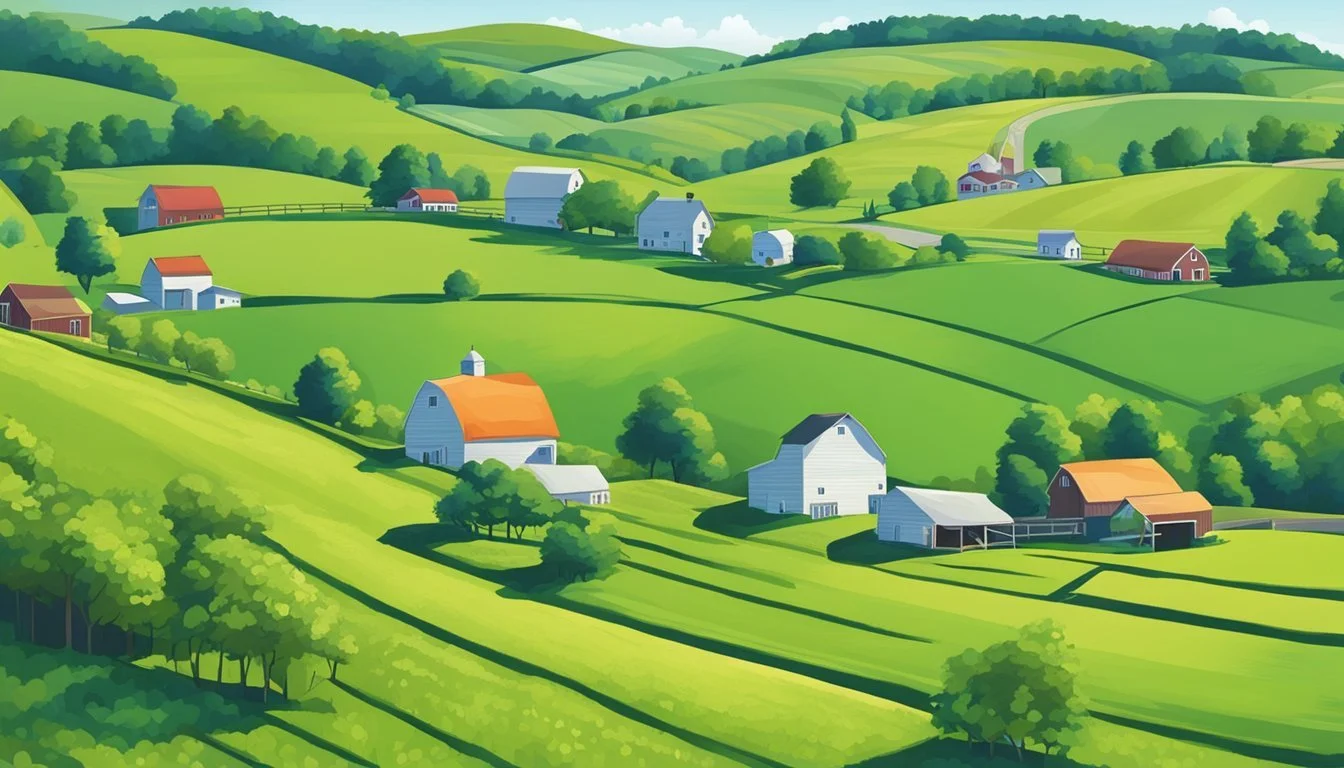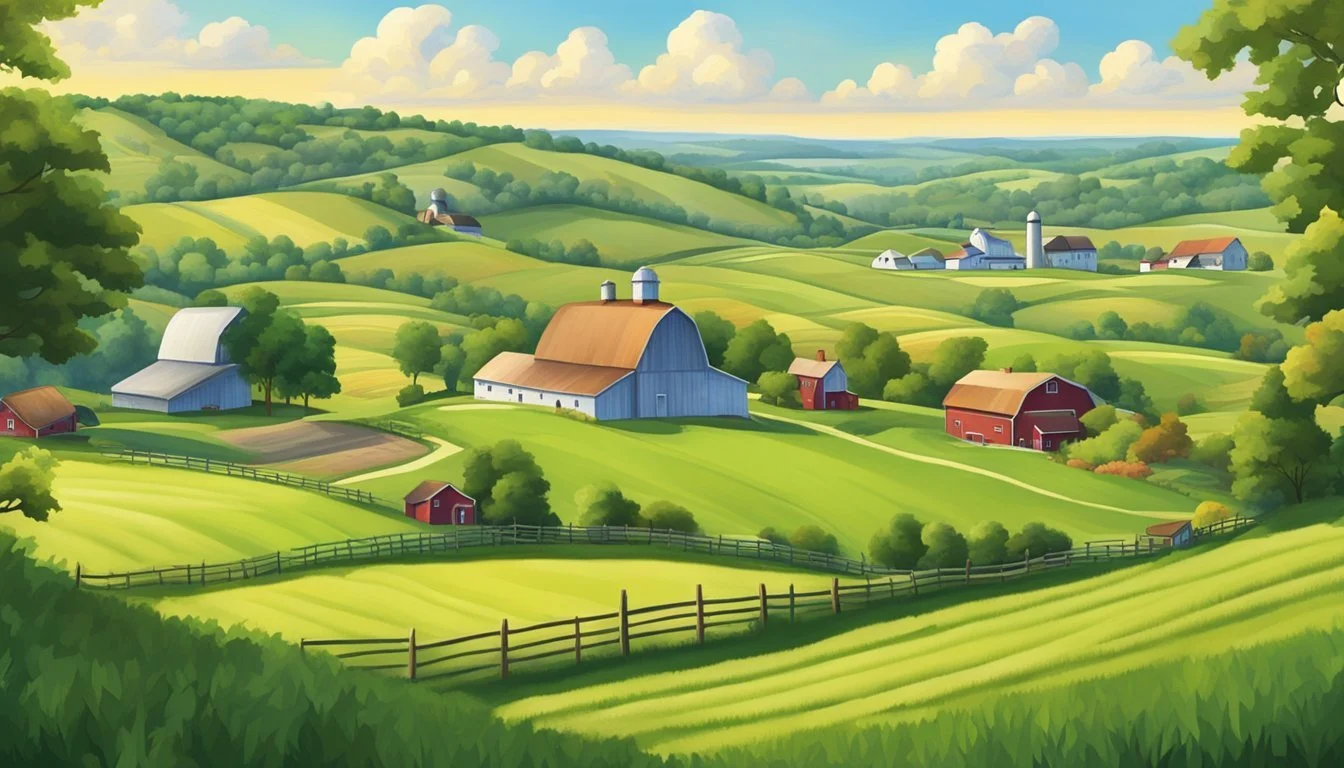Small Farms for Sale in Ohio
Your Guide to Finding the Perfect Rural Property
This Article is Part of State-by-State Guide to Buying Your First Small Farm
Ohio offers a diverse real estate market with a notable segment dedicated to small farms, appealing to buyers looking for rural charm, agricultural opportunities, or a lifestyle change. With properties ranging in size and features, small farms in the state are a cornerstone of local economies, providing potential owners the chance to engage in small-scale agriculture or simply enjoy the sprawling landscapes that Ohio's countryside affords.
These small farms for sale span across the state's varied regions, each with distinct geographical and cultural characteristics. Southern Ohio, known for its rolling hills and wooded areas, presents options for those seeking privacy and natural beauty. In contrast, the central portion offers closer proximity to urban centers and amenities. Within this market, prospective buyers will find farms that feature facilities for livestock, areas for crop cultivation, and homes varying from modest to well-appointed.
The Ohio small farm real estate market is a dynamic field with offerings that fit a range of budgets and needs. The state hosts numerous properties that include both developed and undeveloped land, presenting a variety of choices for individuals seeking the rural life. These farms not only embody the state's agricultural heritage but also represent an opportunity for growth and investment in the heart of the Midwest.
Understanding the Market
The Ohio small farm real estate market is dynamic, with varied factors affecting land availability and pricing. These factors play a significant role in influencing buying decisions and trends in the market.
Current Trends in Ohio's Farm Real Estate
Listings and Availability: Recent trends in Ohio’s farm real estate show a diverse inventory of properties, ranging from modest-sized farms to larger agricultural expanses. Properties vary in size, with 30 to 38-acre farms being notable listings as seen in Carroll, Champaign, and Athens counties.
Regional Variation: The Southeast, Southwest, Central, Northeast, and Northwest regions all have farms available, but the quantity and type of land can vary significantly by region. For example, the Southeast region currently boasts 54 listings, reflecting higher farm real estate activity.
Factors Influencing Prices of Small Farms
Local Market Factors: Prices in the Ohio small farm market are influenced by several factors, including:
The size of the farm, typically reflected in acres
Existing infrastructures, such as houses and barns on the property
Soil quality and topography
For buyers, it’s critical to understand the listing price and price per acre as these figures provide insight into the property’s value.
External Influences:
Zoning laws play a crucial role in Ohio, where agricultural land is typically exempt from stringent regulations, potentially affecting the valuation.
Market demand and economic conditions can lead to fluctuations in farm pricing, affecting both listing prices and the price per acre.
Buyers and investors should pay careful attention to real estate listings and conduct comprehensive research, considering these factors to gauge the small farm market in Ohio accurately.
Types of Small Farms in Ohio
Ohio boasts a variety of small farm types, each offering distinctive lifestyles and opportunities for owners. Whether one seeks a serene hobby farm, a more robust rural mini farm operation, or an idyllic countryside farmette, potential buyers can usually find properties with various land sizes to suit their aspirations.
Hobby Farms and Their Appeal
Hobby farms in Ohio often cater to those looking for a pastoral retreat or an opportunity to engage in small-scale agriculture without the commitment of a full-scale farming operation. These properties typically range from 5 to 50 acres. Buyers are drawn to hobby farms for their manageable size, which allows for personal farming projects such as gardening, raising small livestock, or maintaining orchards.
Rural Mini Farms
Rural mini farms present a middle ground between hobby farming and larger agricultural operations. Properties may vary in size but are generally characterized by parcels of 10 to 100 acres. These farms can support a more diverse and larger scale of agricultural activities, such as cultivating crops, larger scale market gardening, or raising several types of livestock, while still maintaining a rural lifestyle that many find desirable.
Countryside Farmettes
A countryside farmette typically encompasses a smaller tract of land, usually between 5 to 30 acres, but with sufficient space to sustain a family and partake in modest farming activities. These small-scale farms are ideal for those wishing to enjoy the charm of country living while possibly producing income through selling produce, offering farm stays, or establishing a micro-farm focused on specialty crops or artisanal products. Countryside farmettes are the quintessence of rural charm and utility, often featuring a cozy family home within a picturesque landscape.
The Buying Process
When purchasing small farms in Ohio, buyers must carefully evaluate listings, understand the factors influencing purchase prices, and know how to effectively make an offer.
Evaluating Property Listings
When considering small farms for sale in Ohio, prospective buyers should begin by examining property listings. Accurate listings provide critical information about the farm, including acreage, facilities, and residential features. The listing price is typically influenced by:
Land area: More acreage often means a higher price.
Facilities: Barns, stables, or additional buildings add value.
Condition: A well-maintained property commands a higher price.
Buyers should also look for information about the area, such as proximity to markets or urban centers that can affect the farm's operational success.
Understanding the Purchase Price
The purchase price of a small farm is not solely determined by its listing price. It encompasses various other costs, which may include:
Taxes: Property and potential inheritance taxes.
Inspections: Fees for necessary property inspections.
Closing costs: Legal fees and other transactional expenses.
Buyers should be prepared for these additional expenses and understand how they can affect the overall investment.
Making an Offer
Once a buyer has found a suitable property and understands the full financial implications, the next step is making an offer. This process usually involves:
Initial Offer: Communicating a written proposal to the seller.
Negotiations: Discussing terms, which may include adjusting the offer based on property inspections and financing conditions.
Purchase Agreement: Finalizing the sale terms and price, which results in a legally binding contract.
Due diligence in this phase ensures both parties agree to fair terms and the buyer is confident in their investment.
Financial Considerations
When considering the purchase of a small farm in Ohio, it is crucial for buyers to evaluate the full spectrum of financial commitments involved. This section will provide clarity on the costs beyond the initial purchase price and outline the various financing options available for real estate in the agricultural sector.
Estimating Costs Beyond the Purchase Price
In addition to the purchase price, buyers must account for the acreage and its impact on total costs. They should consider:
Closing Costs: Typically 2-5% of the purchase price.
Property Taxes: Varied depending on county and farm size.
Insurance: Costs depend on coverage type and farm size.
Maintenance and Upkeep: Larger acreage might entail higher maintenance costs.
Exploring Financing Options
Prospective buyers have several routes to secure financing for their farm real estate purchase:
Traditional Loans: Local banks or credit unions offering fixed or adjustable rates.
Owner Financing: Where the seller acts as the lender.
Government Programs: Such as USDA loans designed for small farms.
Buyers should compare terms from different financiers, looking at aspects such as down payment requirements, interest rates, and repayment periods.
Pre-Purchase Research
Before investing in a small farm in Ohio, it is essential for a buyer to conduct thorough pre-purchase research. A comprehensive evaluation of the property size, compliance with agriculture zoning, and the quality of soil and water will ensure sound decision-making.
Assessing Acreage and Usability
When examining small farms, the size of the property is a pivotal factor. Acreage determines the potential for farming operations, space for buildings, and the management of livestock. Buyers should confirm property boundaries and consider topography to ensure the acreage is conducive to their intended use, whether it's for cultivation or grazing.
Zoning and Regulatory Compliance
Every farm falls under specific zoning regulations that dictate permissible activities. Buyers should check with local authorities to ensure their desired farming practices align with area zoning. They should also be aware of any conservation easements or other regulations that may affect how they can use the farm.
Soil and Water Quality Testing
Lastly, the health of the farm depends largely on the quality of its soil and water. Adequate testing can reveal nutrient content, pH levels, and any contamination. Since these factors greatly affect crop yield and livestock health, they're crucial to evaluate. Buyers should consider:
Soil Tests: To determine the soil's fertility and need for amendments.
Water Tests: To ensure water sources are safe for crops and animals.
Farming and Livestock
In Ohio, small farms offer a diverse range of agricultural opportunities, particularly in the sectors of animal husbandry and crop production. These activities are foundations of a sustainable farmstead and can lead to profitable ventures when managed effectively.
Raising Animals on Small Farms
When it comes to livestock, small-scale farms in Ohio are particularly suitable for raising a variety of animals including goats, sheep, and poultry. Goats are a versatile choice, as they require less space than larger livestock and can be raised for their milk, meat, or fiber. Sheep are equally beneficial for small farms, offering wool for textiles, in addition to meat and possibly milk. Poultry, such as chickens, ducks, and turkeys, are essential for egg production and meat. Potential owners should consider factors such as:
Space Requirements: Adequate fencing and shelter to protect animals from weather and predators.
Feed and Nutrition: Access to pastures for grazing and a supplemental diet of grains or formulated feeds.
Healthcare Needs: Regular veterinary care, vaccinations, and parasite control are crucial for maintaining animal health.
Raising animals also contributes to soil health through natural manure and can complement crop growing through holistic management practices.
Crop Production Possibilities
Crop production on small Ohio farms presents ample possibilities due to the state’s fertile soil and favorable growing conditions. Farms can consider various marketable crops, including:
Vegetables: High-yield gardens with succession planting to maximize harvest.
Fruits: Orchard crops like apples or berries that cater to both fresh markets and value-added products like jams or ciders.
Grains: Small-scale grain production for specialty markets or on-farm feed use.
Focus on sustainable farming practices allows these farms to often yield a productive crop rotation system that enhances soil fertility and reduces pest and disease occurrences. One could establish a crop-livestock operation where animals and agriculture mutually benefit from each other through practices like rotational grazing.
Understanding the local demand and engaging with community-supported agriculture (CSA) programs can be pivotal in determining the most profitable crops to plant. Farms must also stay abreast of agricultural regulations and organic certification processes if they opt to pursue such markets.




